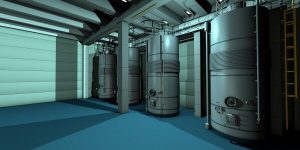We use flammable gas and propane to provide heat to our homes, and we use air conditioners that create toxic waste. Nobody likes to be uncomfortable when it’s too hot or cold. And we try to regulate the temperature around us as much as possible.
But at what cost? Heating and cooling systems are notorious for being bad for the environment. Yet many homes and businesses still use the traditional systems that are killing our planet, and in turn humanity.
Now more than ever is the time to switch our energy consumption to methods. That are eco-friendly and safe for humans for healthy living at home. This article will discuss the most recent innovations in eco-friendly heating and cooling systems alternatives we all rely on so much.
Geothermal

The earth has all the energy we will ever need. The planet will continue to be a source of renewable and eco-friendly fuel to power our daily lives for as long as we allow it.
Geothermal is a good eco friendly heating and cooling systems alternatives. It’s energy comes from the very ground beneath our feet, where temperatures range from 42-80 degrees Fahrenheit.
The thermal energy released from the radioactive decay of natural materials provides the perfect heating and cooling solution that uses sources naturally available to everyone. Technically, it’s free as well.
The downside is that it’s expensive to build reservoirs and systems that can tap into the earth’s crust to take advantage of the natural heat.
The answer to this for some homes is to use a heat pump that doesn’t directly tap into the earth. Rather, they are installed close enough to just use the surrounding heat.
From then, the heat pump can regulate the temperature instead of creating a new energy source. Geothermal units with heat pumps can cool down homes as well as provide much-needed heat.
Solar Heating

Solar heating is another good eco friendly heating and cooling systems alternatives. It relies on the very thing that gives us light in the day, the sun. This energy source won’t run out during our lifetime and will last for the next 10 billion years. In solar heating units, you get passive and active systems.
The passive system will use a building’s exterior, including walls, roofs, and windows, to collect and store energy gathered from the sun. Active forms of solar heating are panels that will install on top of the building. That connects to an internal mechanical system to regulate heat.
Solar heating can also be used to power geysers for those hot baths or showers. But they are costly to install. Most states offer incentives and tax rebates for installing solar heating.
Because the investment is quite a lot initially. Both passive and active solar heating systems will yield major cost benefits. But it could take up to 10 years to get that return on investment.
Heat Pumps

Heat pumps work to both cool down hot air and warm it up in the winter months. It’s the ideal all-in-one solution that can cut energy consumption by five tons per household. It’s another good eco friendly heating and cooling systems alternatives
Most conventional heaters are powered by gas and other fossil fuels which are bad for the environment. Air conditioning units dispose of waste through vents into the outside air. Increasing a person’s carbon footprint.
Heat pumps are electric and don’t rely on any external heating or cooling source to work. Only using an evaporator and condenser coil. Heat pumps alternate the existing air between hot and cold depending on outside temperatures. No additional energy is created since it only moves the heat already available in the air.
Heat pumps are not only great energy savers; they can also cut down costs substantially. When buying a heat pump, the standard lifespan is anywhere from 10-20 years.
They are also extremely easy to install and require less maintenance than standard heating and cooling units. To find out more about heat pump savings, follow Carbon Switch’s guide.
This eco-friendly company provides guides on how to reduce the negative effects. That standard energy-producing units have on the environment.
You can find any guide from LED lighting, to how to control temperatures in your home efficiently. And how you can upgrade to eco-friendly heating and cooling units easily.
Biomass

Biomass is taking energy from all living things in nature, such as plants and trees. It’s a great way to come full circle by utilizing the available energy of the earth.
As long as humans replenish this resource by planting more flora and fauna, the energy source is technically infinite. All living organisms absorb energy from the sun, which we can use to convert into usable heat energy.
Although biomass still releases carbon dioxide, it’s far less than when we burn fossil fuels for energy. Biomass is also another good eco friendly heating and cooling systems alternatives.
The difference between using biomass in place of fossil fuels is that it’s only releasing the same amount of carbon into the air that the plant naturally would have upon its death.
Burning fossil fuels releases any carbon that was trapped inside the earth. And this is devastating to our environment. It’s believed that if homes and businesses started to replace natural gas sources with biomass. That energy consumption on heating bills could save $3.9 billion.
Ice-Powered
This is a simple and innovative idea that someone should have thought of years ago. Ice-powered air conditioners are great energy savers and very eco-friendly. And it’s another good eco friendly heating and cooling systems alternatives.
The system works by freezing a large amount of ice each night. When it’s switched on in the morning, the air is cooled using this ice block. No external air is needed, and each ice block gives up to six hours of cool conditioning.
It works similarly to regular A/C units but is the new environmentally friendly technology currently in progress to experiment with.
Ice-powered air conditioning hasn’t become mainstream yet because it’s still in its early stages of development. Still, it’s easy to see this unit people installing in offices and homes around the world shortly.
Non-Mechanical Solutions
If you still want to go green but you cannot afford to equip your house with a heat pump or solar panels, there are other means to use physics and science.
For one, opening windows at alternating heights around the house can be used to pull and push air because of the angle at which the air is moving. Another method is to install awnings on your roof to keep hot air from coming in through windows and doors.
You can also paint your roof white, because it will reflect the UV rays from the sun, and your house won’t absorb as much heat. For additional heating without the use of geothermal or biomass energy. You can install some portable carpeting to absorb the daily sunlight. At night the carpet will provide much-needed warmth.
If you value the environment as much as your comfort, you will try to change to a greener unit for your heating and cooling needs. There are renewable sources of energy all around us – we just need to find cheaper ways to tap into those sources that won’t harm the environment.
You can be eco-friendly by closing and opening windows and doors to regulate the temperature, but in places where the seasons are tough, heating and cooling is a necessity.
It’s the responsibility of humans to make sure that we don’t put bad chemicals and toxins in the air just because we want to be physically comfortable.




